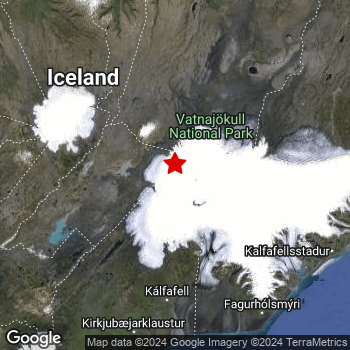In the early morning of Sunday April 21st, 2024, a shallow and significant MAG-5.3 earthquake hit under land 212 kilometer from Reykjavík in Iceland.
Felt the earthquake? Share this article: 



Earthquake Summary
The earthquake struck on land in Iceland, 212 kilometer (132 mi) east-northeast of Reykjavík in Capital Region. The center of this earthquake had a very shallow depth of 10 km. Shallow earthquakes usually have a larger impact than earthquakes deep in the earth.
| Date and Time: | Apr 21, 2024 06:37 (Reykjavik Time) - Apr 21, 2024 06:37 Universal Time. |
|---|---|
| Location: | 212 km ENE of Reykjavík, Capital Region, Iceland. Coordinates 64°31'32"N 17°35'12"W. |
| Map: |  Map of area around epicenter. Click to open in Google Maps. |
| Magnitude: | MAG 5.3 Detected by 27 stations. Maximum Error Range ±0.06 . |
| Depth: | 10 km (6 mi) A very shallow depth. |
| Tsunami Risk: | Tsunami very unlikely While this was a shallow earthquake, it appears to have occurred under land with a magnitude not strong enough to cause tsunami's. Always stay cautious - More info here. |
Nearby towns and cities
This earthquake may have been felt in Iceland . Located 131 kilometer (81 mi) south of the epicenter of this earthquake, Akureyri (Northeast, Iceland) is the nearest significant population center.
An overview of nearby towns and cities is available in the overview below.
Overview of nearby places
| Distance | Place |
|---|---|
| 131 km (81 mi) N from epicenter |
Akureyri Northeast, Iceland. |
| 212 km (132 mi) WSW from epicenter |
Reykjavík Capital Region, Iceland. |
| 213 km (132 mi) WSW from epicenter |
Kópavogur Capital Region, Iceland. |
| 216 km (134 mi) WSW from epicenter |
Hafnarfjörður Capital Region, Iceland. |
Aftershocks detected
This main shock was followed by 1 smaller aftershock. A 3 magnitude earthquake hit 16 mins later 18 km (11 mi) north-northeast of this earthquake.
Overview of foreshocks and aftershocks
| Classification | Magnitude | When | Where |
|---|---|---|---|
| Main Shock This Earthquake |
M 5.3 |
Apr 21, 2024 06:37 (Reykjavik Time) | - |
| Aftershock | M 3.0 |
16 mins later Apr 21, 2024 06:53 (Reykjavik Time) | 18 km (11 mi) NNE from Main Shock. |
More earthquakes coming?
Aftershocks are usually at least 1 order of magnitude less strong than main shocks. The more time passes, the smaller the chance and likely strength of any potential aftershocks.
In only six percent of cases, significant earthquakes are followed by a larger main shock, making the current earthquake a foreshock. While the chance of this happening is not so large, it is adviced to maintain cautiousness in the hours and days following a major earthquake.
Read: How to Stay Safe during an Earthquake (cdc.gov).Earthquakes like this happen often in the region
Earthquakes of this strength are very common in the region. This is the strongest earthquake to hit since November 10th, 2023, when a 5.3 magnitude earthquake hit 253 km (157 mi) further west-southwest. An even stronger magnitude 6 earthquake struck on June 21st, 2020.
In total, 40 earthquakes with a magnitude of 5.3 or higher have been registered within 300km (186 mi) of this epicenter in the past 10 years. This comes down to an average of once every 3 months.
Tsunami very unlikely
While MAG-6.5+ earthquakes may cause tsunami's, it appears that the epicenter of this earthquake hit under land. In addition, the reported depth is deeper than 100km, making the risk of a tsunami even less likely. However always stay cautious and monitor advice from local authorities.
Tsunami Risk Factors
| Factor | Under Sea? | MAG-6.5 or stronger? | Shallow depth? |
|---|---|---|---|
| Explanation | Almost all tsunami's are caused by earthquakes with their epicenter under sea or very near the sea. However stay cautious in coastal areas as earthquakes on land may cause landslides into sea, potentially still causing a local tsunami. | Under MAG 6.5: Very unlikely to cause a tsunami. MAG 6.5 to 7.5: Destructive tsunami's do occur, but are uncommon. Likely to observe small sea level changes. MAG 7.6+: Earthquakes with these magnitudes might produce destructive tsunami's. |
Most destructive tsunami's are caused by shallow earthquakes with a depth between 0 and 100km under the surface of the earth. Deeper tsunami's are unlikely to displace to ocean floor. |
| This Earthquake | Not this earthquake. This earthquake appears to have struck on land far from any coast. |
Not this earthquake. This earthquake had a magnitude of 5.3. Earthquakes of this strength are unlikely to trigger a tsunami. |
This earthquake occurred at a depth of of 10 km (6 mi). Earthquakes this shallow could trigger a tsunami. |
Sources
Last updated 04/05/24 07:38 (). This article is automatically generated based on available data. We keep checking multiple sources for additional information. This article gets updated as new details on this earthquake become available.


